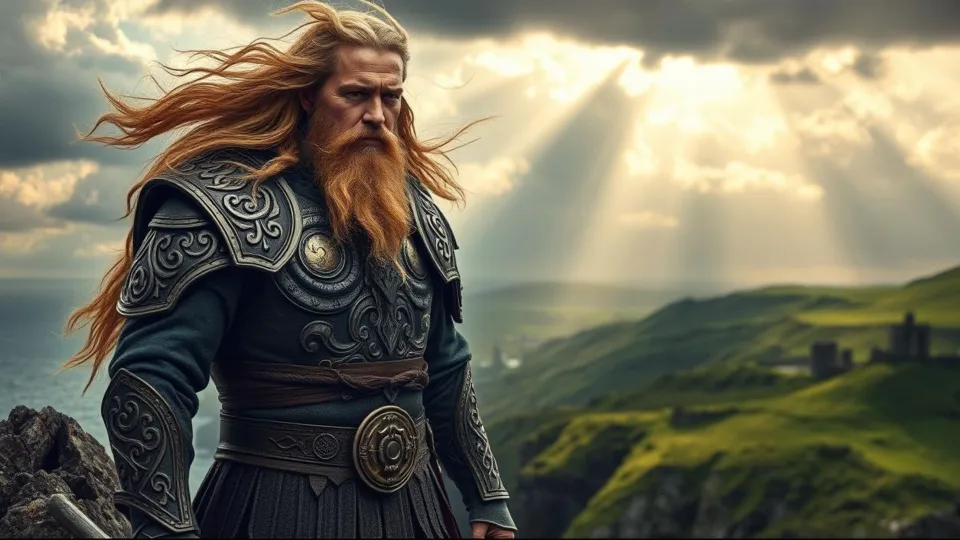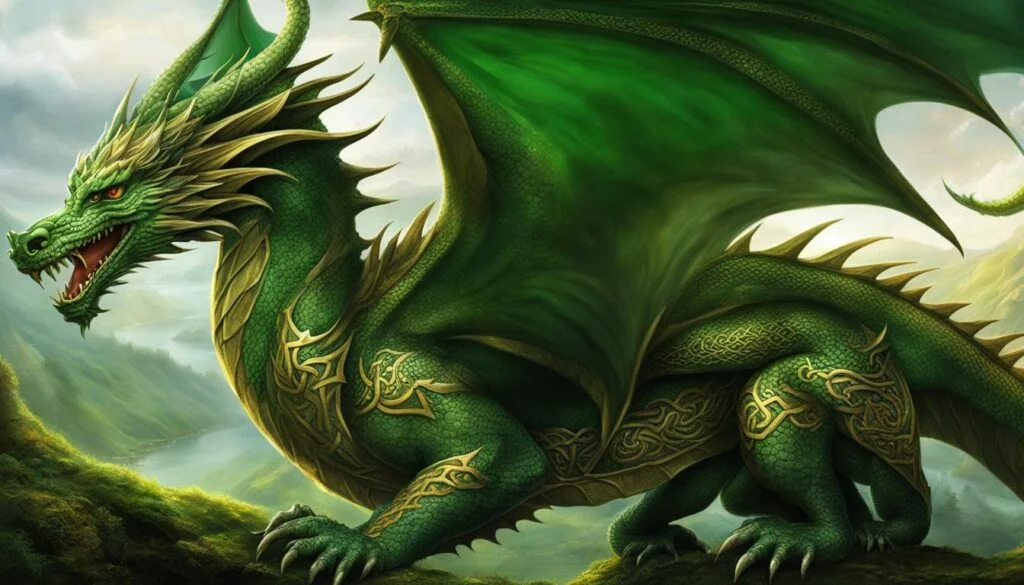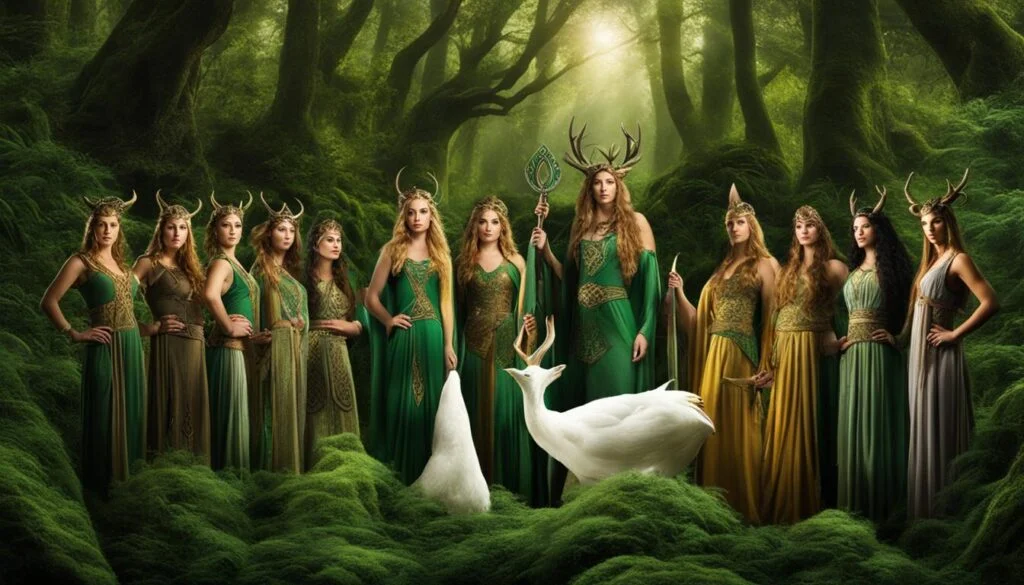Míl Espáine is a key figure in Irish myths. He is seen as the ancestor of the Irish Gaels.
He was a brave soldier from Spain, tracing back to a legendary king named Breogán.
A 16th-century artwork by Hermann tom Ring shows him. It’s in the Bavarian State Painting Collections now.
Some say Míl Espáine was made up by medieval Irish writers. But his story lives on in Irish stories as a hero.
His name means “soldier of Hispania” in Latin.
His story tells of a hero who didn’t make it to Ireland.
But his kids, the Milesians, became part of Irish history.
Key Takeaways
- Míl Espáine is a key figure in Irish myths, seen as the ancestor of the Irish Gaels.
- He comes from Breogán, a legendary king, and his name means “soldier of Hispania” in Latin.
- Now, historians think Míl Espáine was made up by medieval Christian writers.
- The Historia Brittonum from the 9th century talks about his role in leading the Milesians to Ireland.
- His sons, the Milesians, settled in Ireland and formed important groups in different areas.
Origins and Etymology of Míl Espáine
The story of Míl Espáine takes us on a journey through Irish and Latin languages.
It shows how the Irish language and its roots in Latin shape its history.
Etymological Background
The name Míl Espáine comes from the Latin ‘miles Hispaniae’, meaning ‘soldier of Hispania’.
This name links him to Latin and Irish stories. It shows how language and culture mix in Míl Espáine’s story.
Latin to Irish Transformation
Míl Espáine changed from Latin to Irish, showing how languages change over time.
This change shows Latin’s effect on Irish, marking a period of language growth. Míl Espáine’s story is tied to these changes, showing how Latin and Irish mixed.
Historical Context
Míl Espáine is found in important texts like Historia Brittonum and Lebor Gabála Érenn.
These texts mix myths with history, showing a shift from paganism to Christianity.
Míl Espáine’s tale reflects these changes, making him a key figure in Irish identity and language history.
Míl Espáine in Irish Origin Myths
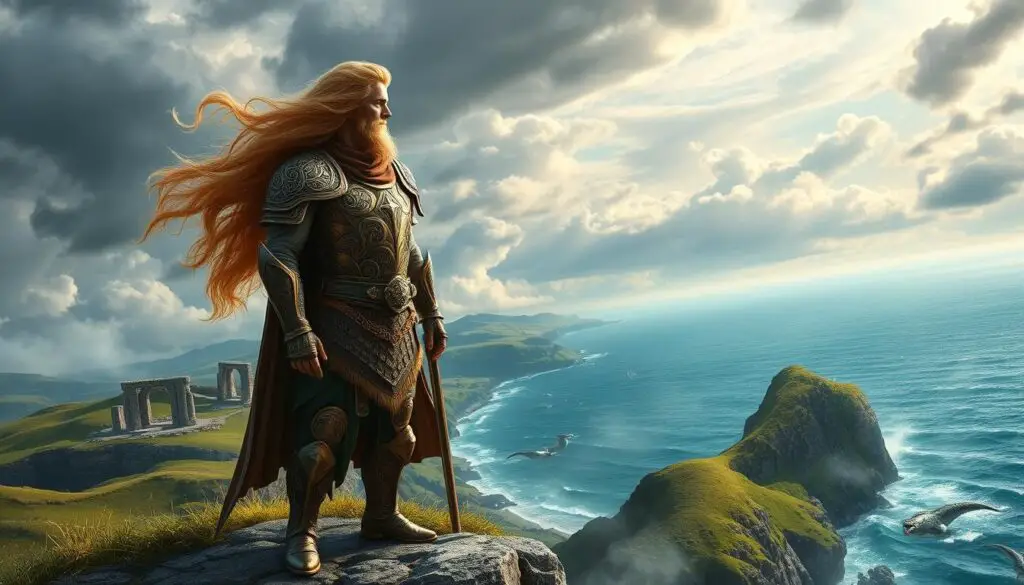
Míl Espáine is a key figure in Irish stories. He is important in the Historia Brittonum and the Lebor Gabála Érenn.
These stories show how Míl Espáine changed Irish history.
The Historia Brittonum
The Historia Brittonum tells us Míl Espáine was a leader. He led people from the Iberian Peninsula to Ireland.
Ireland was settled by three groups from there.
The Lebor Gabála Érenn
The Lebor Gabála Érenn adds more to Míl Espáine’s story. Written in the 11th century, it talks about his family line.
It says the Milesians, who settled Ireland, came from Míl Espáine.
Legacy in Irish Mythology
Míl Espáine’s story goes beyond his own adventures. He is seen as a prince who conquered Iberia and then Ireland.
His family, like Amergin, divided Ireland among the Gaels and the Tuatha Dé Danann.
His story ties Ireland’s mythic past to its culture.
Role in the Book of Invasions
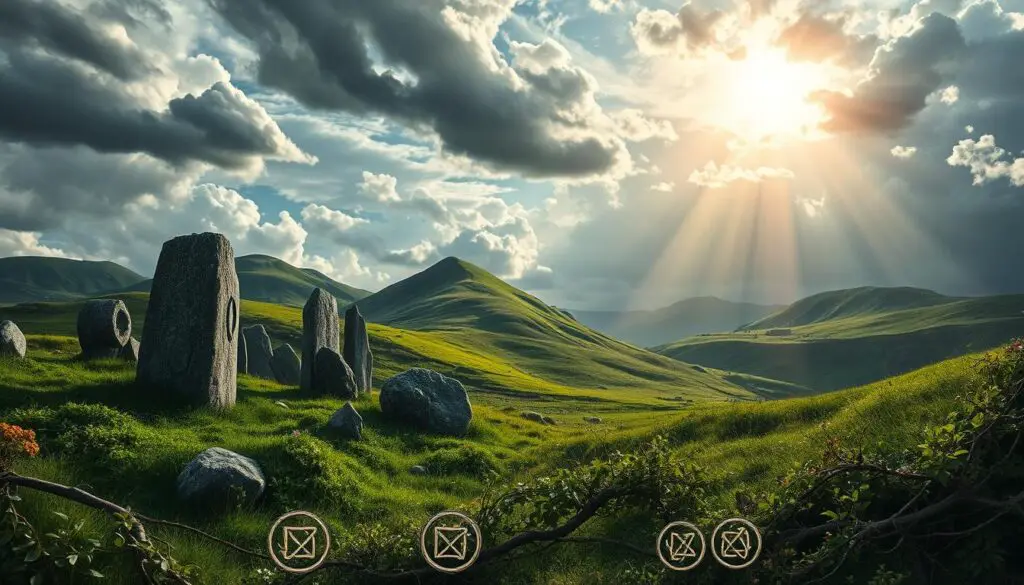
The Book of Invasions, also known as Lebor Gabála Érenn, was written by an unknown author in the 11th century.
It mixes Irish myths and history. Míl Espáine is a key figure whose family, the Milesians, beat the Tuatha Dé Danann and took over Ireland.
The Book has ten parts, from the world’s creation to after Christianity came. It tells of six invasions, adding to Ireland’s myths.
These invasions made Ireland’s myths richer.
The Lebor Gabála Érenn was seen as true history by scholars until the 19th century. It has over 136 poems and stories about these invasions.
It was influenced by Christian works, giving it a historical feel.
The sons of Míl sought revenge for Íth’s death and won Ireland. This story is a key myth for the Gaelic people.
It links history and myth, giving the Irish a shared past.
Manuscripts like The Book of Leinster and The Great Book of Lecan keep the Lebor Gabála Érenn alive.
They show the text’s importance and its detailed look at Ireland’s past. The First and Second Redactions are found in these books.
In conclusion, the Book of Invasions tells the Irish people’s story. It mixes myths with Christian and pagan traditions.
This gives us a deep look into Ireland’s mythological history.
The Connection to Iberia
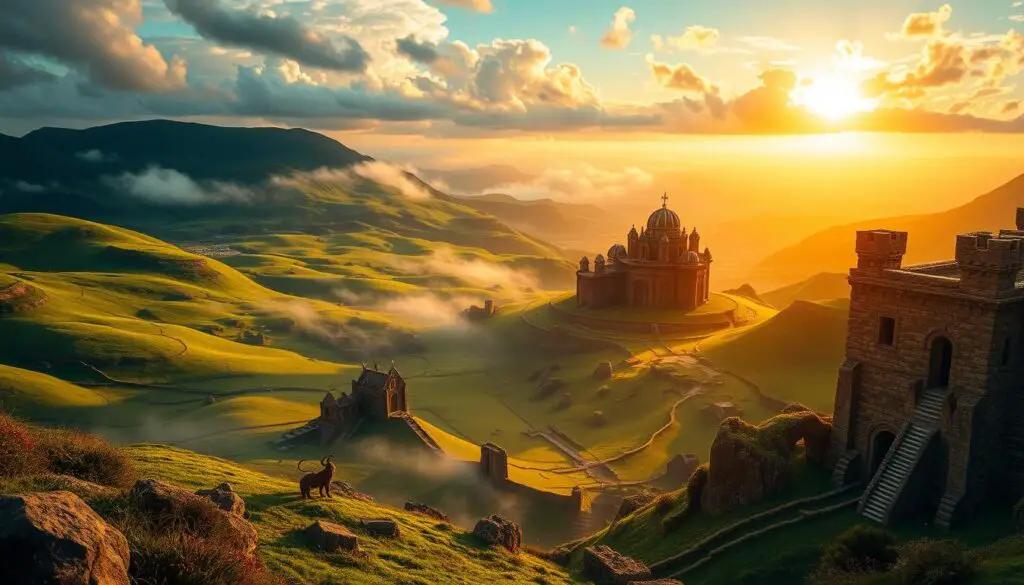
Looking into Míl Espáine’s roots shows a deep Iberian connection. This link joins Ireland and the Iberian Peninsula’s cultures.
It’s a story full of myths and history.
The Iberian Influence
The Iberian Peninsula greatly influenced Irish myths. The Gaels, Ireland’s ancestors, came from there.
They brought stories of the Tower of Babel with them.
These Gaedhael descendants made their mark in Iberia. Ith, a key figure, linked their story with Iberian lands and traditions.
This shows the lasting effect of their journey.
Isidore of Seville’s Contribution
Isidore of Seville, a famous scholar, called Iberia the “mother of all races.” His work linked Hibernia (Ireland) and Iberia geographically and genealogically. He tied Míl Espáine’s story to the Tower of Breogán in Galicia.
This story connects Spain and Ireland’s cultures deeply. It shows how history, myth, and reality are linked. This shared story still affects us today.
Scythian and Egyptian Adventures
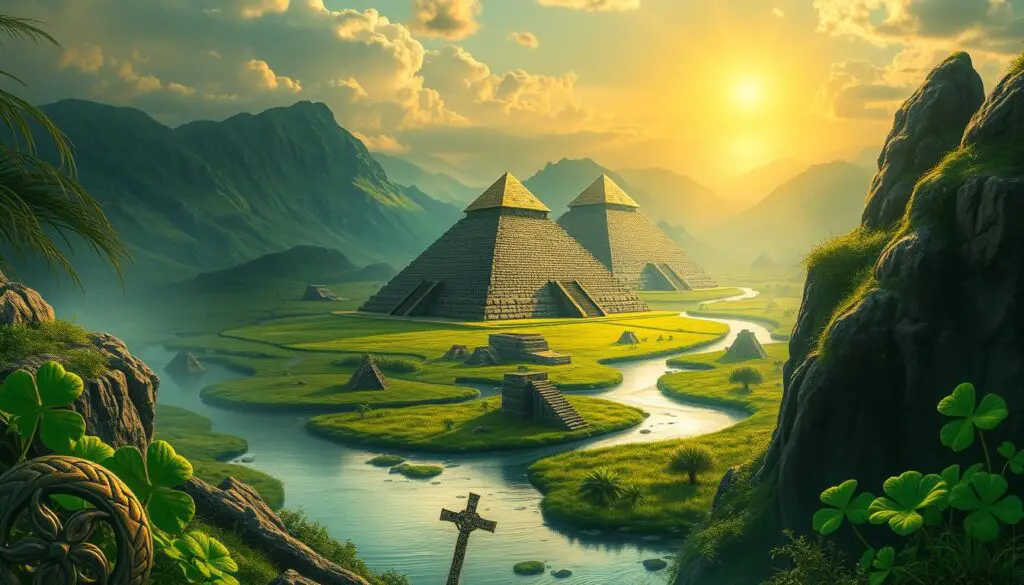
Míl Espáine went on a legendary journey across ancient lands.
He mixed Scythian legend with Egyptian mythology in Ireland. He showed great skill in battle and leadership in Scythia.
Time in Scythia
Míl Espáine spent time in Scythia, where he was part of a rich cultural mix.
Stories tell of a Scythian settlement in the isles, linking these areas closely.
A Stone Figure from Ireland and a Scythian Kurgan Stele from Kyrgyzstan show this connection.
Irish Goddess Brigid and Scythia’s Goddess Tabiti share many traits.
Both cultures valued red hair, blue eyes, and chariot skills. Art like Scythian gold and the Scythian Ibex shows their cultural exchange.
Journey to Egypt
After his Scythian adventures, Míl went to Egypt. He married Scota, the Pharaoh’s daughter.
This marriage linked Irish and Egyptian mythologies, starting a cultural mix in Ireland.
The Milesians, or Sons of Mil, are Ireland’s ancient invaders.
They are the Celts’ ancestors. Names like Niall of the Nine Hostages and Conn of the Hundred Battles come from this line.
This marriage started a big cultural mix, linking Ireland to world history.
The Legend of Breogán and the Tower
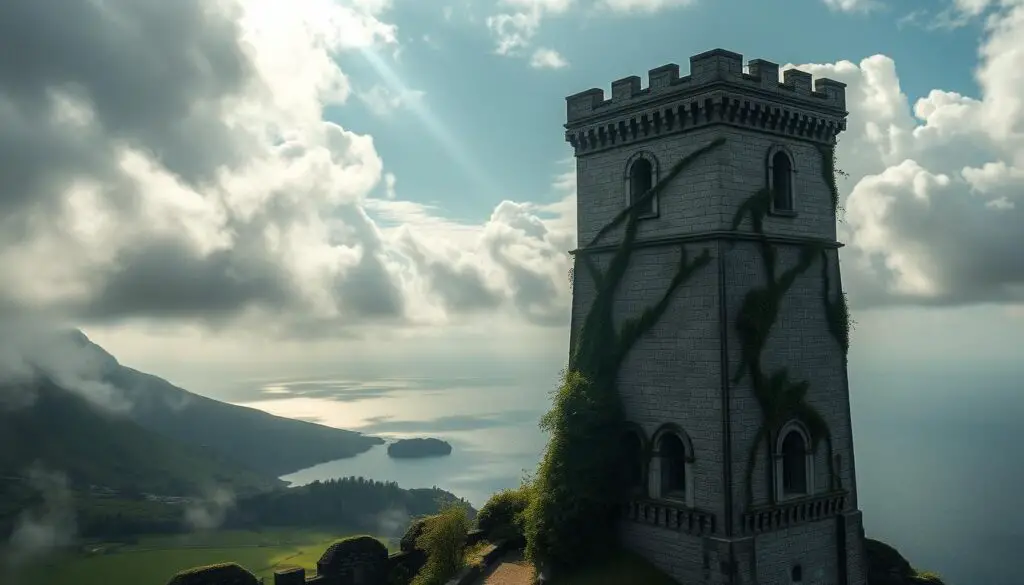
The story of Míl Espáine isn’t full without the tale of his granddad, Breogán. Lebor Gabála Érenn, a medieval Christian history of Ireland, calls Breogán a key Gael ancestor.
He built the city of Brigantia, now A Coruña in Galicia, and the famous Breogán’s Tower.
Breogán’s Tower is a big part of Galician heritage. It links Irish-Spanish folklore together.
The tower, believed to be the Torre de Hercules, was where Íth saw Ireland from afar. This sight led to the Gaels’ great journey from Iberia to new lands after 440 years of travel.
A 2006 study by Oxford University found most people in the British Isles come from neolithic farmers in Northern Spain.
This links the legend to science, showing a deep connection between the past and present.
Breogán, with nine sons including Bile, made a big mark on history and culture.
His legacy lives on in the Tower of Hercules, the world’s oldest working lighthouse and a UNESCO site since 2009.
The tale of Breogán’s Tower deepens our knowledge of Irish-Spanish folklore.
It shows how myths from different lands and times are still important today. In Galicia, Breogán is still celebrated in statues, media, and even a basketball club, CB Breogán.
Arrival in Ireland
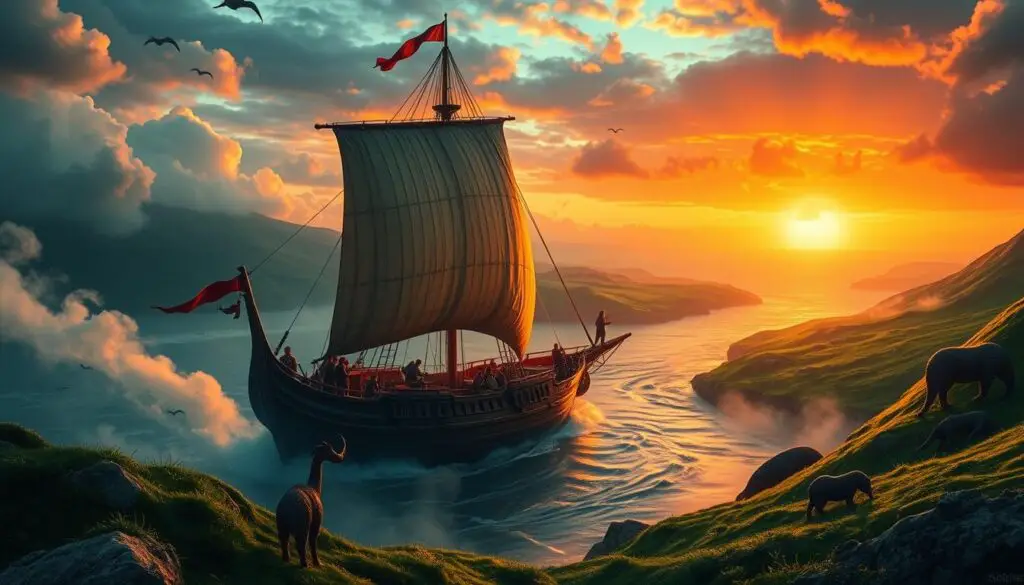
Míl Espáine and his kin arrived in Ireland, starting a key event in Irish stories. This event led to a big fight.
Confrontation with the Tuatha Dé Danann
When they came to Ireland, Míl Espáine’s people met the Tuatha Dé Danann.
The battle was not just a fight. It was a big struggle between gods and humans.
Míl’s people won, changing Ireland’s politics and beliefs.
The Division of Ireland
After winning, the island was split between the winners and the losers.
The Milesians got the land, and the Tuatha Dé Danann went to the Otherworld. This shows how myths and history mixed in Ireland.
These stories helped the Milesians claim Ireland, shaping its history and politics.
Legacy of Míl Espáine’s Descendants
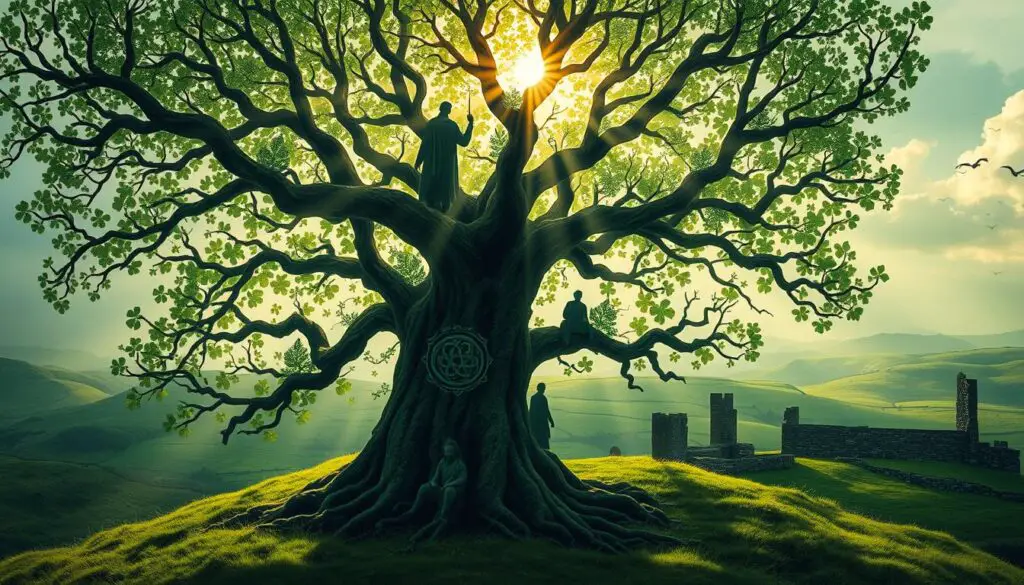
The Milesians, or descendants of Míl Espáine, are key in Irish history. They helped shape the Gaelic dynasties and the Milesian legacy.
They link the mythic past to the social order of ancient Ireland.
The Lebor Gabála Érenn tells us how Míl’s sons took over Ireland. Éber Finn ruled Munster, while Érimón’s line spread across Connacht, Leinster, and parts of Ulster. Ír’s line was strong in Ulster.
These stories show how the Gaelic dynasties spread and their impact.
Irish stories honor these ancient leaders. Names like Éber Finn, Éremón, and Heber mac Ír are linked with lions.
These symbols show their noble roots. They symbolize the lasting Milesian legacy that has lasted for centuries.
The stories also tell of their battles and victories. They talk about how they divided the land and ruled it.
This story shows their big impact on Irish history. It keeps alive the memory of the Gaelic dynasties from Míl Espáine’s line.
Myth vs. Historical Fact
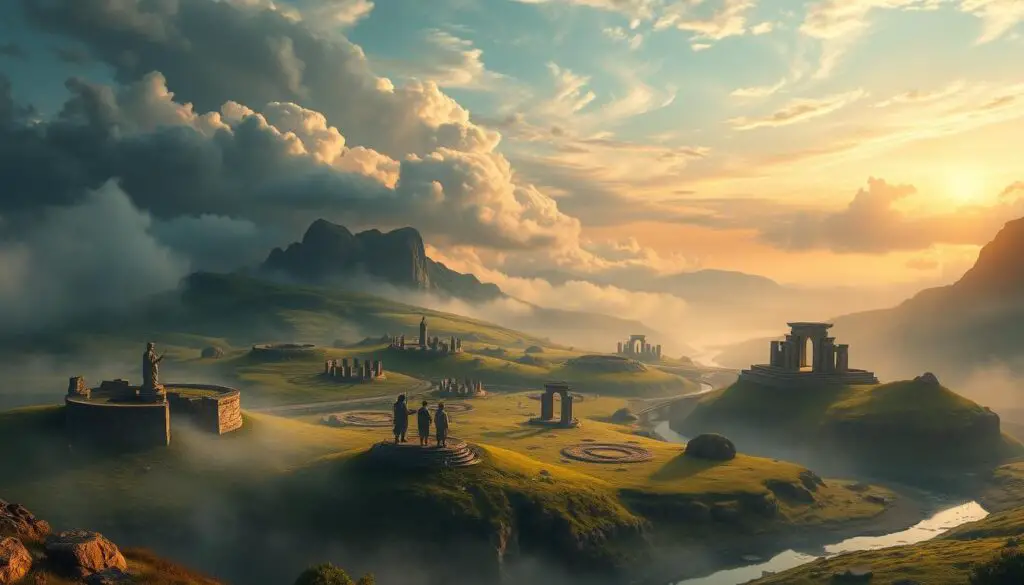
The story of Míl Espáine is both interesting and complex. Scholars and fans often argue about what’s myth and what’s fact.
Historical Skepticism
Many people doubt the stories of old. Campbell wrote about a possible move from Ireland to northwest Britain around AD 500.
But, there’s little proof in Argyll to back this up.
There’s no sign of Gaelic language in Argyll’s place names. Also, early Scots’ brooches don’t show Gaelic style.
This points to a cultural change, not a big move of people.
Medieval Christian Influence
Christianity also changed old Irish stories. It made them fit into a Christian story. Bede was one who helped change these tales.
These new stories were then made even bigger by Scots in the 10th century. They linked Ireland’s history to the Bible.
This helped make new leaders seem right.
Trying to match these stories with what archaeologists find shows problems. Some think the language change happened long before the Roman times.
This makes the old stories hard to believe.
The term “Scotti” used by Romans includes all Gaelic speakers, making things even more confusing.
Significance for Irish Culture and Identity
The story of Míl Espáine deeply affects Irish culture and identity. It gives the Irish people noble roots.
The Milesians, Míl’s descendants, are key in Irish myths. They left a lasting mark that still lives in Ireland today.
Their epic journey is told in the “Book of Invasions.” It shows how they mixed with the Tuatha Dé Danann.
This mix created a strong culture that lasts.
Impact on Irish Genealogy
Míl Espáine and his family’s legacy is felt in Irish history. Families like the Uí Néill and the Eóganachta come from the Milesians.
They are important in politics and culture because of their history.
Studies show Irish roots go back to Northern Spain. This proves the deep historical and genetic links with the area. It gives the Irish a strong sense of pride and belonging.
Symbolism in Irish Folklore
Míl Espáine and the Milesians symbolize Irish traditions. Places like the Hill of Tara tell stories of old battles and settlements.
These stories help shape who the Irish are today.
The Leprechaun Museum in Dublin shows how myths still capture people’s imaginations.
Music, like Horslips’ album “The Book of Invasions,” also connects with these stories. It shows how Míl Espáine’s legend is still alive in Irish culture.
Frequently Asked Questions
Q: Who are the three sons of Milesius?
The three sons of Milesius are often referred to as Heber, Heremon, and Ith in Irish mythology. They are said to have led the Milesian invasion of Ireland and are considered ancestors of many of the ancient Irish royal families.
Q: Who was Milesius King of Spain?
Milesius, also known as Mil Espáine, is a mythological figure purported to be a king from Spain who fathered the sons that invaded and took Ireland from the Tuatha Dé Danann, establishing the Gaelic presence on the island.
Q: What is the difference between the Milesians and the Tuatha de Danann?
The Milesians are depicted as mortal ancestors of the modern Irish, representing the last wave of invaders who conquered Ireland and brought it into the human realm, while the Tuatha Dé Danann are described as god-like beings possessing supernatural powers, who receded into the earth to become the fairy folk of Ireland.
Q: When was the Milesian invasion of Ireland?
The Milesian invasion of Ireland is a mythological event with no exact historical date. It is described in Irish folklore as having occurred at a time when the island was ruled by the mystical Tuatha Dé Danann.
Q: Who are the so-called Milesians?
In Irish mythology, the so-called Milesians are the descendants of Milesius, the King of Spain. They are depicted as the final wave of Celts who invaded and settled Ireland, overthrowing the Tuatha Dé Danann and becoming the forebears of the modern Irish people.


